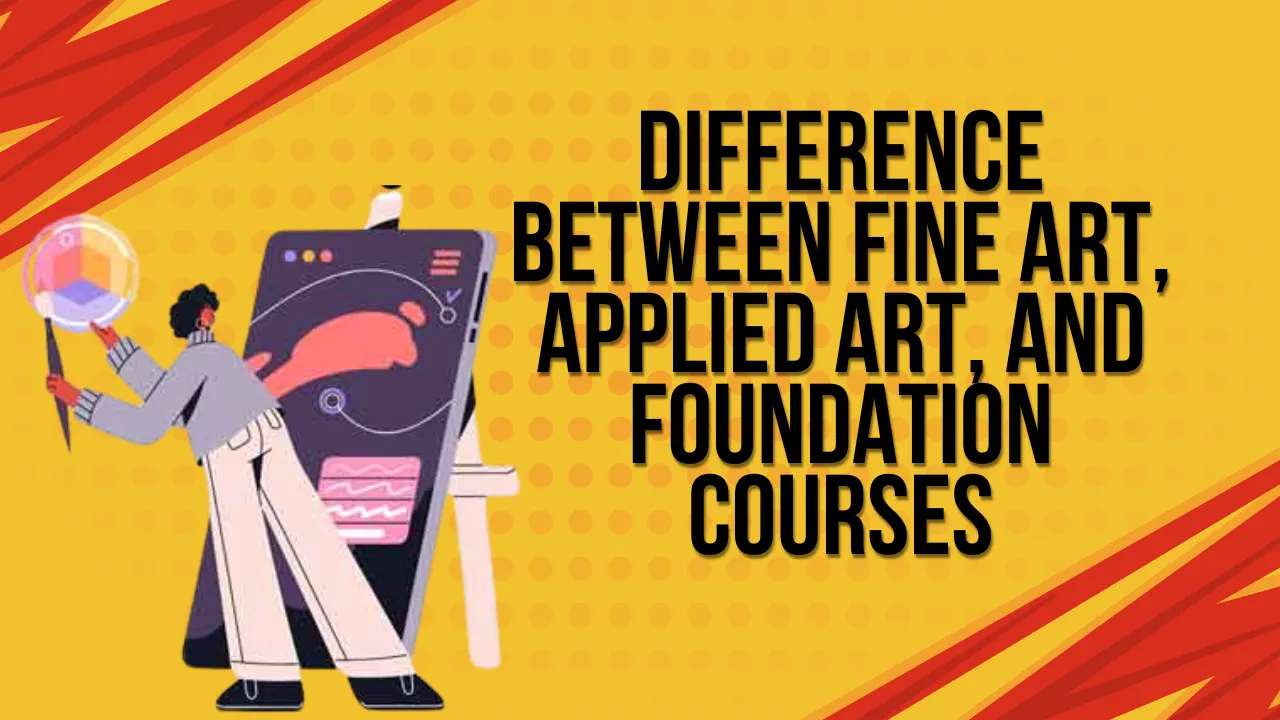Difference Between Fine Art, Applied Art, and Foundation Courses: Difference Between Fine Art, Applied Art, and Foundation Courses is a common question among students planning to enter the creative field. These courses are often confused due to their overlap in art-related subjects, but they lead to very different careers and learning experiences.
This article will clearly explain the difference between fine art, applied art, and foundation courses in simple terms. We will explore what each course involves, who should choose which path, and what career options come with each. If you’re thinking about studying art but aren’t sure where to begin, this guide will help you decide with confidence.
1. What is Fine Art?
Fine Art focuses on creativity and self-expression. It includes subjects like painting, sculpture, printmaking, and drawing. The main aim of fine art is not to serve a practical function but to create something beautiful or meaningful. It is more about personal vision and individual expression.
Students of fine art spend a lot of time developing their own unique style. This course is ideal for those who want to become artists, painters, or sculptors. Museums, galleries, and art collectors are often the end users of fine art creations.
2. What is Applied Art?
Applied Art is about applying artistic skills to practical purposes. This includes graphic design, advertising, product design, interior design, animation, and fashion design. While creativity is still at the center, the final outcome usually serves a specific function or solves a real-world problem.
In applied art, students learn to work with clients, follow project briefs, and produce work that communicates a clear message. This course is perfect for those who want to work in creative industries like media, branding, or design firms.
3. What is a Foundation Course?
A Foundation Course is a one-year introductory program for students who want to explore art and design before choosing a specialization. It gives basic training in drawing, design principles, color theory, and material handling.
This course helps students discover their interests and strengths. It’s especially useful for those who are unsure whether they should choose fine art or applied art. After completing the foundation year, students can select the path that best suits their skills and goals.
4. Key Differences in Course Structure
- Fine Art:
- Focus on creativity and concept
- Studio-based practice
- Emphasis on personal projects
- Focus on creativity and concept
- Applied Art:
- Focus on client-based work
- Mix of theory and real-world assignments
- Often includes digital tools
- Focus on client-based work
- Foundation Course:
- Basic introduction to both fine and applied art
- Helps in portfolio building
- Ideal for beginners
- Basic introduction to both fine and applied art
5. Career Paths After Each Course
- After Fine Art:
- Painter
- Sculptor
- Gallery artist
- Art educator
- Art therapist
- Painter
- After Applied Art:
- Graphic designer
- Animator
- Fashion designer
- UI/UX designer
- Advertising creative
- Graphic designer
- After Foundation Course:
- Further studies in fine or applied art
- Entry-level art jobs
- Portfolio for art school admissions
- Further studies in fine or applied art
6. Skills Gained from Each Course
- Fine Art:
- Personal creativity
- Deep artistic expression
- Observation and visualization
- Personal creativity
- Applied Art:
- Communication through design
- Digital software skills
- Practical problem-solving
- Communication through design
- Foundation Course:
- Basic art techniques
- Time management
- Understanding of different materials and media
- Basic art techniques
Key Points in List Format:
- Fine Art:
- Purely creative
- Personal and expressive
- Ideal for independent artists
- Purely creative
- Applied Art:
- Functional creativity
- Focused on industry needs
- Great for commercial jobs
- Functional creativity
7. Which One Should You Choose?
Choosing between these courses depends on your interests. If you love expressing ideas freely through visual art and want to become a professional artist, go for fine art. If you prefer working on creative projects with real-world uses, applied art will suit you better. If you’re still exploring your options, a foundation course gives you time and guidance to decide.
Many colleges in Maharashtra and across India offer all three options, so students can start from a foundation course and then move into their desired field.
FAQs:
1. Can I take a foundation course after 12th?
Yes, foundation courses are usually open to students after 12th grade, especially those from any stream interested in art and design
2. Do I need to be good at drawing for applied art?
Basic drawing skills help, but applied art also focuses on design and concepts. Software skills and creative thinking are equally important.
3. Is fine art a good career choice?
Yes, if you’re passionate and consistent. With effort and networking, fine art can lead to a successful career in galleries, commissions, and art teaching.
4. Can I switch from foundation to applied or fine art?
Yes, that’s the purpose of the foundation course. It helps you decide which direction to take.
5. Which course offers better job chances?
Applied art generally offers more direct job opportunities in industries like media, advertising, and design.
Final Thought:
Understanding the difference between fine art, applied art, and foundation courses is the first step toward a successful creative career. Whether you’re driven by personal expression, commercial creativity, or just starting your artistic journey, there is a course tailored for you. Think about your passion, explore your interests, and choose wisely.
If this article helped you understand your options, leave a comment or share it with a friend! You can also explore your creative horoscope and learn more about the best art careers today!











